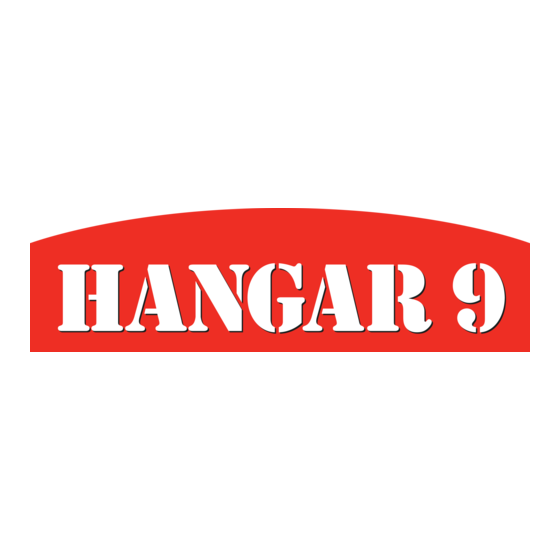
Table of Contents
Advertisement
Quick Links
Twist
Specifications
Wingspan: ............... 47.75 in (1212.85mm)
Length: .................... 48. 38 in (1228.73mm)
Wing Area: .............. 747.37 sq in (48.2 sq dm)
Plug-N-Play
™
ASSEMBLY MANUAL
Weight: ................... 5.0–6.0 lb (2.27 kg–2.72 kg)
Radio: ..................... 4-channel w/5 servos
Engine: .................... Evolution™ .46 NT
�
��
™
Advertisement
Table of Contents

Summary of Contents for Hangar 9 Twist Plug-N-Play
- Page 1 � �� Twist Plug-N-Play ™ ™ ASSEMBLY MANUAL Specifications Wingspan: ....47.75 in (1212.85mm) Weight: ....5.0–6.0 lb (2.27 kg–2.72 kg) Length: ....48. 38 in (1228.73mm) Radio: ..... 4-channel w/5 servos Wing Area: ....747.37 sq in (48.2 sq dm) Engine: ....
-
Page 2: Table Of Contents
Table of Contents Covering Colors ..............2 Additional Required Tools and Adhesives. -
Page 3: Contents Of Kit
Contents of Kit Replacement Parts A. Wing w/Aileron HAN2877 B. Fuselage HAN2876 C. Tail Set HAN2878 D. Landing Gear HAN2654 E. Canopy HAN2879 F. 2 " Wheels HAN305 Items Not Shown Fuel Tank HAN2479 Engine Mount HAN40M Decal Set HAN2880 Field Equipment Required •... -
Page 4: Before Starting Assembly
Before Starting Assembly Before beginning the assembly of your Twist™ Plug-N-Play™, remove each part from its bag for inspection. Closely inspect the fuselage, wing panels, rudder and stabilizer for damage. If you find any damaged or missing parts, contact the place of purchase. If you find any wrinkles in the covering, use a heat gun or covering iron to remove them. -
Page 5: Section 1: Installing The Tail Section
Section 1: Installing the Tail Section Required Parts Step 2 • Stabilizer assembly • Fuselage Locate the stabilizer/elevator assembly. Position the • Rudder assembly stabilizer/elevator assembly so the control horn will face down, away from the fin. The threaded rods from the Required Tools and Adhesives rudder/fin assembly will slide into the two holes in the •... -
Page 6: Section 2: Landing Gear Installation
Section 2: Landing Gear Installation Required Parts • Fuselage assembly • 8-32 x 1/2" screw (2) Required Tools and Adhesives • Phillips screwdriver (large) • Threadlock Step 1 Locate the main landing gear and two 8-32 x 1/2" screws. Attach the main landing gear using the screws. -
Page 7: Section 3: Propeller And Spinner
Section 3: Propeller and Spinner Required Parts Step 4 • Fuselage • Propeller Locate the two #4 x 5/8" sheet metal screws. Position the • Spinner spinner cone onto the spinner backplate, making sure it keys into the backplate. Use the screws and a Phillips •... -
Page 8: Section 4: Radio Installation
Section 4: Radio Installation Required Parts Step 2 • Fuselage assembly • Wing assembly Route the antenna to the rear of the fuselage through the installed tube. The tube is located on the left side of the Required Tools and Adhesives fuselage right before the throttle servo tray. -
Page 9: Section 5: Linkage Installation
Section 5: Linkage Installation Required Parts Step 3 • Fuselage assembly • Wing assembly Center the rudder servo electronically using the radio system. Attach the pushrod with clevis to the control horn. Step 1 Thread the clevis in or out so the aileron is in neutral with Center the elevator servo electronically using the radio the radio on. -
Page 10: Section 6: Attaching The Wing To The Fuselage
Section 6: Attaching the Wing to the Fuselage Required Parts • Wing • Fuselage • 1/4-20 x 2" nylon bolt Required Tools and Adhesives • Flat blade screwdriver Step 1 Place the wing onto the fuselage. Secure the wing using the 1/4-20 x 2"... -
Page 11: Control Throws
Control Throws Low Rate High Rate Step 3 Aileron 1" (15°) up " (23°) up Before you fly, be sure that your engine idles reliably, transitions and runs at all throttle settings. Only when 1" (15°) down " (23°) down this is achieved should any plane be considered ready Elevator 1"... -
Page 12: Preflight
Preflight Charge both the transmitter and receiver pack for your airplane. Use the recommended charger supplied with your particular radio system, following the instructions provided with the radio. In most cases the radio should be charged the night before going out flying. Check the radio installation and make sure all the control surfaces are moving correctly (i.e. -
Page 13: Notes
Notes... -
Page 14: 2005 Official Ama National Model Aircraft Safety Code
2005 Official AMA National Model Aircraft Safety Code GENERAL 7) I will not operate models with pyrotechnics (any device that explodes, burns, or propels a projectile 1) I will not fly my model aircraft in sanctioned of any kind) including, but not limited to, rockets, events, air shows or model flying demonstrations until explosive bombs dropped from models, smoke it has been proven to be airworthy by having been... - Page 15 2005 Official AMA National Model Aircraft Safety Code 5) Flying sites separated by three miles or more Organized RC Racing Event are considered safe from site-to site interference, 10) An RC racing event, whether or not an AMA Rule even when both sites use the same frequencies. Any Book event, is one in which model aircraft compete circumstances under three miles separation require in flight over a prescribed course with the objective of...
- Page 16 � �� © 2005 Horizon Hobby, Inc. 4105 Fieldstone Road Champaign, Illinois 61822 (877) 504-0233 horizonhobby.com 7901...
















Need help?
Do you have a question about the Twist Plug-N-Play and is the answer not in the manual?
Questions and answers